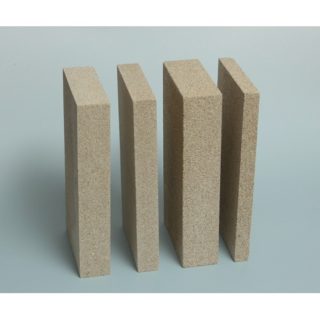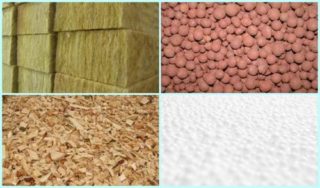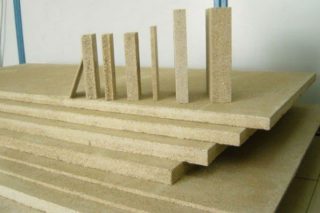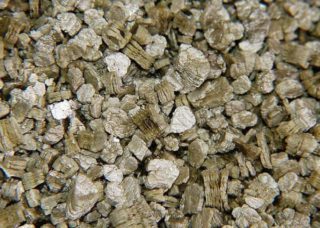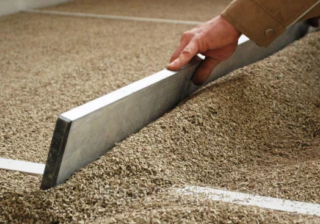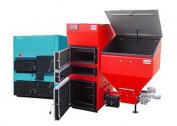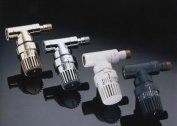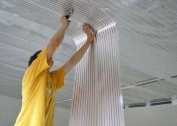When warming building structures, mineral wool or bulk compositions are traditionally used - most often from expanded clay. They attract the attention of professional builders with a relatively low price and good thermal insulation performance. However, they are replaced by vermiculite plates made on the basis of natural components and not containing harmful substances. This insulation in its technical indicators is comparable with the parameters of mineral wool, but surpasses it in durability and soundproofing properties.
Type of insulation
Vermiculite insulation material is made on the basis of a rock of volcanic origin, which includes several chemical elements and natural impurities. Thanks to this composition, it has a special bronze or golden hue. In construction, expanded or foamed vermiculite materials obtained by heat treatment of the original mineral at temperatures of the order of 900-1200 ° are mainly used.
Intensive heat exposure causes a significant increase in the initial volume - it increases by about 20-25 times. As a result of heat treatment, vermiculite insulation acquires the properties of a material characterized by low thermal conductivity and increased density. The thermal conductivity of vermiculite material takes the values of 0.04-0.12 W / m * K.
Material Features and Specifications
The characteristics of vermiculite slabs are represented by the following operating parameters:
- thermal conductivity;
- strength indicators;
- soundproof properties;
- fire resistance and thermal stability;
- hygroscopicity.
A feature of thermal insulation materials based on vermiculite is considered to be a high thermal conductivity, obtained due to the layered structure. Between the thin plates in the plate array there are voids into which air easily penetrates. This does not weaken the bonds between the structural elements of the material, so that it has sufficient strength. The vermiculite plate is not inferior to mineral wool blanks in thermal conductivity, but surpasses them in deformation stability.
Another feature of the insulation is its good hygroscopicity - the ability to absorb moisture. But thanks to the layered structure, it also easily gives it away - it protects the elements of building structures from decay and destruction. Good sound absorption is achieved due to the elasticity of the material and other characteristics. The maximum sound absorption can be achieved by compressing the plate to a state where its volume decreases by 20%.
Thermal insulation material melts when the temperature reaches 1300 ° C, during a fire it does not form any harmful emissions.
Plate sizes
Vermiculite is produced in the form of discrete fractions, the size of which does not exceed 4 mm (in the form of filling). Based on them, construction boards of the PVO-500 type are made with a thickness of about 20-60 mm and sizes 600x600 mm (1200x600 mm). The assortment of this material includes the following five sizes of vermiculite products: 1200x600x20 mm, 900x600x20 mm, 600x600x20 mm, 600x300x20 mm and another atypical size 300x300x20 mm.
Advantages and disadvantages
The advantages of vermiculite are more convenient to consider in comparison with mineral wool, which is a guideline for assessing the quality of insulation material. In relation to it, plates based on vermiculite are more durable, due to their high strength. In this indicator, it surpasses expanded clay and perlite.
Among the advantages of insulation also include the following properties:
- blanks from vermiculite are not inferior to mineral wool in basic indicators;
- plates do not retain moisture without forming condensation inside building structures under conditions for the removal of steam;
- with a sheet thickness of 15 mm, the boards are resistant to open flame for 45 minutes.
The latter circumstance allows the use of vermiculite for decorating fireplaces installed in private homes.
In terms of their ability to absorb noise, such plates surpass all previously listed heaters. In addition, heat-insulating material made from rocks is environmentally friendly and does not emit substances harmful to human health. For the same reason, it is cheaper than other heaters, including mineral wool.
The disadvantages of this type of heat insulators include:
- due to the high hygroscopicity of the material during the installation of insulation boards, it will be necessary to ensure good ventilation of the premises;
- during their production, incomplete removal of particles of asbestos harmful to humans is possible;
- when purchasing material, you should make sure that you have a quality certificate confirming its safety.
If you consider all the problem areas of products from vermiculite, its use is considered fully justified.
Areas of use
Vermiculite slabs are sometimes used for insulation of walls, floors and roofs of buildings under construction. High fire resistance and the ability to maintain their shape allow you to use them in the following areas:
- for warming attic rooms;
- for insulation of pipes of household stoves and fireplaces;
- in order to protect the walls located next to the chimneys;
- as packaging material used in the transportation of fragile and valuable goods;
- in metallurgy - to reduce heat loss during steel spills;
- as heat-resistant steam insulation of gas ducts, boilers and thermal furnaces for industrial use.
Often this material is used as a component of the pie, which is arranged when finishing fireplace designs.
Terms of use
When applying this material, you will need to follow certain rules:
- on top of the insulating layer, a diffuse membrane that performs the function of a waterproofing is necessarily arranged;
- attics warmed by vermiculite must be ventilated by artificially organizing a pressure drop;
- when warming frame structures or structures of the “well masonry” type, vermiculite plates are placed in voids between bricks or structural elements;
- products are stacked in the cavity gradually as the structure is assembled.
The current building regulations prescribe the fastening of plates by any means available for this. However, free laying of workpieces is not excluded if they are placed in cavities without gaps.
Vermiculite combinations
Despite the quite affordable price and undeniable advantages, when used without additives, vermiculite slabs are quite expensive during construction. For this reason, they are used in combination with other insulation materials. To reduce production costs, vermiculite is often mixed with sawdust.In this combination, the finished product retains its original characteristics and does not become denser due to its own weight over time.
When mixing the components of finishing materials with granules of vermiculite, a composition called “warm plaster” is obtained. The specified combination has undeniable advantages when compared with the usual methods of surface finishing of walls. This is manifested in the fact that in plaster with vermiculite the specific gravity is slightly lower than in other similar compositions.
According to the main thermal indicators and other determining parameters, the considered combination also surpasses them.
A 25-mm pie of plaster and vermiculite allows you to achieve the same thermal insulation performance as a 100-150-mm layer of a mixture of cement and sand. The stucco mixture prepared in this form is calmly applied to almost any surface to be trimmed, including masonry and concrete slabs.
Manufacturers
Among the well-known manufacturers of materials and plates based on vermiculite, the following domestic firms and companies stand out:
- LLC PKO Dmitrovskaya Heat Insulation (Dmitrov city). The main activity is the production of firmware and shaped products from vermiculite.
- Group of companies SFR (Kolpino city). The main activity is the production and sale on a wholesale scale of a wide range of diverse insulation materials.
- Dry building mixtures, expanded vermiculite, as well as a number of samples of materials for electrical engineering are produced by specialists from the Leningrad region.
- Vermit Trading House from Chelyabinsk is engaged in the production and sale of fire retardant compositions and boards using vermiculite.
Organika from Chelyabinsk and several other small companies that do not deserve special attention can be added to this list.
